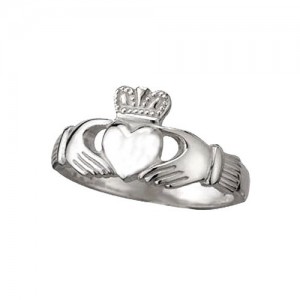 EE writes: “I would be very grateful if you could help me with a question. My boyfriend and I want to get married. We are both Spanish but we share a nice bond with Ireland due to several reasons. My boyfriend would like to give me a Claddagh wedding ring but I am not sure if it´s an occult symbol. I may sound a bit simplistic, I know the history behind it, and I know it´s very popular in Ireland. The problem is that I have dwelt in the occult a long time ago and I do not want anything to do with it again. Could you please help me and confirm whether or not is an occult symbol?”
EE writes: “I would be very grateful if you could help me with a question. My boyfriend and I want to get married. We are both Spanish but we share a nice bond with Ireland due to several reasons. My boyfriend would like to give me a Claddagh wedding ring but I am not sure if it´s an occult symbol. I may sound a bit simplistic, I know the history behind it, and I know it´s very popular in Ireland. The problem is that I have dwelt in the occult a long time ago and I do not want anything to do with it again. Could you please help me and confirm whether or not is an occult symbol?”
The Claddagh ring is not associated with the occult.
This lovely little symbol consists of two hands holding or presenting a heart over which is carved a design like a crown or fleur de lis. The phrase that usually accompanies the ring is “Let Love and Friendship Reign”.
Writing in The Mantle, Father George Quinn, explains that the name of the Claddagh ring originates in the Irish word cladach which means “shore”. It is so named for its origin in Claddagh, Galway, a small fishing community in western Ireland. Before the village was razed in the 1930’s, it had its own King who oversaw the fishing industry in the town. It was here that the ring originated and is still used to this day as a marriage or friendship ring.
Father Quinn cites the legend of Richard Joyce as being the originator of the Claddagh ring.
Joyce was a silversmith from Galway who was captured and enslaved by Algerian Corsairs while in route to the West Indies. He was sold into slavery to a Turkish goldsmith who taught him the craft. It was Joyce who designed the first Claddagh ring, but it wasn’t seen in his native land until William III demanded the release of all British subjects being held in Algiers. The government reluctantly complied and Joyce returned to Galway in 1689. He married soon after his return and was a successful silversmith for the rest of his life. His initials can be found on several chalices and although there is no existing Claddagh ring bearing his stamp, it is generally believed that Joyce designed it while in Algiers. He may have fashioned it after similar Egyptian rings found in the area.
The Claddagh ring has been made in this town ever since.
I found a blog that suggests each element of the Claddagh symbol may have been associated with a different Pagan god but the blog did not offer any sources for this information and I have been unable to find anything credible that suggests the same.
“Beauthuaile (the representation of all life) was the crown, Anu (the ancestral and universal mother of the Celts) the left hand, Dagda Mór (father of the Celtic Gods) the right hand, and the heart was the heart of all mankind that gives everlasting music to the Gael. When Christianity came along, this probably switched over to the crown being the Father, the left hand the Son and the Right hand the Holy Spirit. This correlates to the Shamrock, the oldest symbol of the Holy Trinity in Ireland.”
The problem with this speculation is that the Claddagh ring is believed to have originated in the 1700s, long after its ancient pagan celtic roots. By the time the ring came into existence, the country was predominately Christian.
Father Quinn makes no mention of pagan roots to the ring and goes on to explain the different ways that it is meant to be worn:
“The ring was used by these people as a marriage ring and even down to the present day the ring amongst them has special age—old customs. For instance, it is not right for a Claddagh person to buy a ring, they must obtain it as a gift. If married, the crown must be put on nearest the nail. If unmarried, the heart is being presented; it is free to be captured, so the crown is worn nearest the knuckle.”
I don’t see any problem with you and your beloved exchanging this beautiful symbol on your wedding day. May the good Lord bless your union with much love and happiness.









